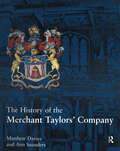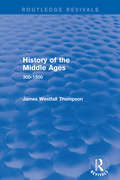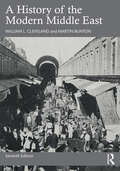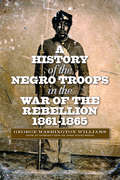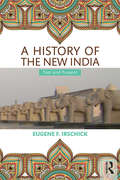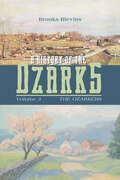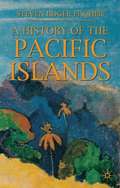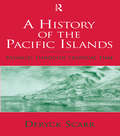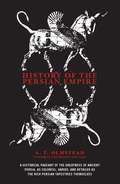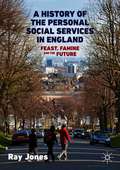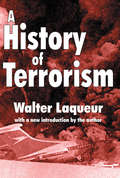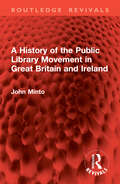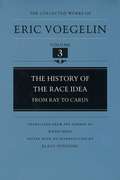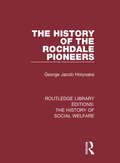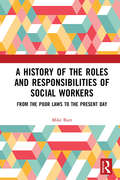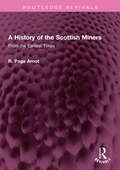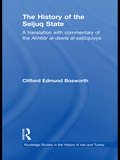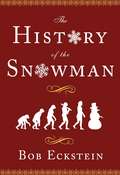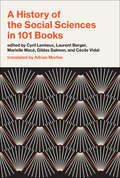- Table View
- List View
The History of the Merchant Taylors' Company
by Matthew DaviesOne of the 'Great Twelve' livery companies of the City of London, the Merchant Taylors' Company has been in existence for some seven hundred years. This new history will chart the remarkable story of the Company and its members from its origins until the 1950s, encompassing the lives and achievements of men such as Sir Thomas White (founder of St John's College, Oxford) and the celebrated chronicler, John Stow, as well as the roles played by the Company in the City and beyond in different periods. As well as looking in detail at the internal life of the Company, the book will also focus on a number of important themes in the wider history of London. These include trade and industry, apprenticeship, the impact of religious change, the foundation of schools and other charities, and the government and politics of the City. In doing so, the book will contribute to an understanding of the aims and activities of the livery companies over the centuries, their ability to adapt to changing circumstances and their relevance in a modern world far removed from that in which they were first established. The History of the Merchant Taylors' Company will appeal to a wide range of people interested in the history of London. It is fully illustrated with more than seventy-five black and white and thirty colour illustrations.
History of the Middle Ages: 300-1500
by James Westfall ThompsonFirst published in 1931, this book covers the broad period of time between the Christian Roman Empire instituted in the fourth century and the period of the Renaissance. The author traces the main events of medieval history — striking a balance between political, institutional, social and cultural history — with no event of major importance escaping recognition. In addition to covering medieval Europe in detail, it also includes sections on the Byzantine Empire and the foundation of Islam. Many maps are also included to geographically illustrate key points. This book will be of interest to students of history.
A History of the Modern Chinese Navy, 1840–2020 (Routledge Studies in the Modern History of Asia)
by Bruce A. EllemanThis book provides a comprehensive history of the modern Chinese navy from 1840 to the present. Beginning with a survey of naval developments in earlier imperial times, the book goes on to show how China has since the mid-19th century four times built or rebuilt its navy: after the Opium Wars, a navy which was sunk or captured by the Japanese in the war of 1894–1895; during the 1920s and 1930s, a navy again sunk or lost to Japan, in the war of 1937–1945; in the 1950s, a navy built with Soviet help, which stagnated following the Sino-Soviet split in the early 1960s; and finally the present navy which absorbed its predecessor, but with the most modern sections dating from the 1990s—a navy which continues to grow and prosper. The book also shows how the underlying strategic imperative for the Chinese navy has been the defense of China’s coasts and major rivers; how naval mutiny was a key factor in the overthrow of the Qing and the Nationalist regimes; and how successive Chinese governments, aware of the potent threat of naval mutiny, have restricted the growth, independence, and capabilities of the navy. Overall, the book provides—at a time when many people in the West view China and its navy as a threat—a rich, detailed, and realistic assessment of the true nature of the Chinese navy and the contemporary factors that affect its development.
A History of the Modern Middle East
by William L. Cleveland Martin BuntonA History of the Modern Middle East examines the profound and often dramatic transformations of the region in the past two centuries, from the Ottoman and Egyptian reforms, through the challenge of Western imperialism, to the impact of US foreign policies. Built around a framework of political history, while also carefully integrating social, cultural, and economic developments, this expertly crafted account provides readers with the most comprehensive, balanced, and penetrating analysis of the modern Middle East.The seventh edition has been substantially revised to reflect the significance of the 2011 Arab Uprisings as a major turning point in the modern history of the region. A new chapter considers how regional powers, especially in the Gulf, are now asserting themselves more forcefully, seeking to push their own interests while Russia and China contest America’s position. Including an annotated and updated bibliography that offers guidance to readers seeking more in-depth information and incorporating an online companion website featuring quizzes, timelines, and instructor resources, A History of the Modern Middle East remains the quintessential text for courses on Middle Eastern history.
A History of the Negro Troops in the War of the Rebellion, 1861-1865
by George Washington Williams John David SmithA History of the Negro Troops in the War of the Rebellion, 1861–1865 (originally published in 1888) by pioneer African American historian George Washington Williams remains a classic text in African American literature and Civil War history. In this powerful narrative, Williams, who served in the U.S. Colored Troops, tells the battle experiences of the almost 200,000 black men who fought for the Union cause. Determined to document the contributions of his fellow black soldiers and to underscore the valor and manhood of his race, Williams gathered his material from the official records of U.S. and foreign governments and from the orderly books and personal recollections of officers commanding Negro troops during the American Civil War. <p><p> The new edition of this important text includes an introductory essay by the award-winning historian John David Smith. In his essay, Smith narrates and evaluates the book’s contents, analyzes its reception by contemporary critics, and evaluates Williams’s work within the context of its day and its place in current historiography.
A History of the New India: Past and Present
by Eugene F. IrschickProviding a different approach to the history of India than previously advocated, this textbook argues that there was constant interaction between peoples and cultures. This interactive, dialogic approach provides a clear understanding of how power and social relations operated in South Asia. Covering the history of India from Mughal times to the first years of Independence, the book consists of chapters divided roughly between political and thematic questions. Topics discussed include: Mughal warfare and military developments The construction of Indian culture Indian, regional and local political articulation India’s Independence and the end of British Rule Women and governmentality The rise of the Dalit movement As well as a detailed timeline that provides a useful overview of key events in the history of India, a set of background reading is included after each chapter for readers who wish to go beyond the remit of this text. Written in an accessible, narrative style, the textbook will be suitable in courses on Indian and South Asian history, as well as courses on world history and South Asian studies.
A History of the Ozarks, Volume 2: The Conflicted Ozarks
by Brooks BlevinsThe Ozarks of the mid-1800s was a land of divisions. The uplands and its people inhabited a geographic and cultural borderland straddling Midwest and west, North and South, frontier and civilization, and secessionist and Unionist. As civil war raged across the region, neighbor turned against neighbor, unleashing a generation of animus and violence that lasted long after 1865.The second volume of Brooks Blevins's history begins with the region's distinctive relationship to slavery. Largely unsuitable for plantation farming, the Ozarks used enslaved persons on a smaller scale or, in some places, not at all. Blevins moves on to the devastating Civil War years where the dehumanizing, personal nature of Ozark conflict was made uglier by the predations of marching armies and criminal gangs. Blending personal stories with a wide narrative scope, he examines how civilians and soldiers alike experienced the war, from brutal partisan warfare to ill-advised refugee policies to women's struggles to safeguard farms and stay alive in an atmosphere of constant danger. The war stunted the region's growth, delaying the development of Ozarks society and the processes of physical, economic, and social reconstruction. More and more, striving uplanders dedicated to modernization fought an image of the Ozarks as a land of mountaineers and hillbillies hostile to the idea of progress. Yet the dawn of the twentieth century saw the uplands emerge as an increasingly uniform culture forged, for better and worse, in the tumult of a conflicted era.
A History of the Ozarks, Volume 3: The Ozarkers
by Brooks BlevinsBetween the world wars, America embraced an image of the Ozarks as a remote land of hills and hollers. The popular imagination stereotyped Ozarkers as ridge runners, hillbillies, and pioneers—a cast of colorful throwbacks hostile to change. But the real Ozarks reflected a more complex reality. Brooks Blevins tells the cultural history of the Ozarks as a regional variation of an American story. As he shows, the experiences of the Ozarkers have not diverged from the currents of mainstream life as sharply or consistently as the mythmakers would have it. If much of the region seemed to trail behind by a generation, the time lag was rooted more in poverty and geographic barriers than a conscious rejection of the modern world and its progressive spirit. In fact, the minority who clung to the old days seemed exotic largely because their anachronistic ways clashed against the backdrop of the evolving region around them. Blevins explores how these people’s disproportionate influence affected the creation of the idea of the Ozarks, and reveals the truer idea that exists at the intersection of myth and reality. The conclusion to the acclaimed trilogy, The History of the Ozarks, Volume 3: The Ozarkers offers an authoritative appraisal of the modern Ozarks and its people.
A History of the Pacific Islands
by Steven Roger FischerFrom the back cover: This wide-ranging study of the Pacific Islands provides a dynamic and provacative account of the peopling of the Pacific, and its broad impact on world history. Spanning nearly 50,000 years of human presence in an area which comprises one-third of our planet - Melanesia, Micronesia and Polynesia - the narrative follows the development of the region, from New Guinea's earliest settlement to the creation of the modern Pacific states.
A History of the Pacific Islands: Passages through Tropical Time
by Deryck ScarrA book about the past and present Pacific Islands, wide-ranging in time and space spanning the centuries from the first settlement of the islands until the present day.
History of the Persian Empire
by A. T. OlmsteadOut of a lifetime of study of the ancient Near East, Professor Olmstead has gathered previously unknown material into the story of the life, times, and thought of the Persians, told for the first time from the Persian rather than the traditional Greek point of view. "The fullest and most reliable presentation of the history of the Persian Empire in existence."—M. Rostovtzeff
A History of the Personal Social Services in England: Feast, Famine and the Future
by Ray JonesThis book provides a detailed narrative and analysis of the 50-year development of the personal social services in England, located throughout the changing ideological, political and relevant professional contexts of the period. Drawing on the experience and recollections of key players who were active during major moments, it constitutes a significant addition to the social work and social policy literature, synthesising important and often original evidence, and some provocative interpretations. The book speaks to crucial on-going issues and contentious current debates, such as the place of bureaucratic management structures in ‘practices with people' generally, and social work specifically. It will be of interest to student and qualified social workers, social policy students and researchers, and policy makers, as well as those with a general interest in the history and trajectory of current issues facing social work and social care in England.
A History of the Polish Americans: A History Of The Polish-americans (Minorities In Modern America Ser.)
by John.J. BukowczykIn the last, rootless decade families, neighborhoods, and communities have disintegrated in the face of gripping social, economic, and technological changes. Th is process has had mixed results. On the positive side, it has produced a mobile, volatile, and dynamic society in the United States that is perhaps more open, just, and creative than ever before. On the negative side, it has dissolved the glue that bound our society together and has destroyed many of the myths, symbols, values, and beliefs that provided social direction and purpose. In A History of the Polish Americans, John J. Bukowczyk provides a thorough account of the Polish experience in America and how some cultural bonds loosened, as well as the ways in which others persisted.
A History of the Public Library Movement in Great Britain and Ireland (Routledge Revivals)
by John MintoOriginally published in 1932, A History of the Public Library Movement in Great Britain and Ireland is concerned with the rise and progress of the public library as it stood at that time. The establishment and growth of the public library may be viewed as part of the great social movement for the spread of knowledge among the poorer classes which took place in the late eighteenth century and the early years of the nineteenth century. This movement was characterized by the establishment of various educational agencies, which are covered in this book, along with the introduction of the Public Libraries Act passed in 1850 and other legislation that followed.
The History of The Race Idea: From Ray to Carus (Collected Works of Eric Voegelin #3)
by Eric Voegelin Ruth Hein Klaus VondungIn The History of the Race Idea: From Ray to Carus, Eric Voegelin places the rise of the race idea in the context of the development of modern philosophy. The history of the race idea, according to Voegelin, begins with the postChristian orientation toward a natural system of living forms. In the late seventeenth century, philosophy set about a new task--to oppose the devaluation of man's physical nature. By the middle of the eighteenth century the effort of philosophy was to place man, with his variety of physical manifestations throughout the world, within a systemic order of nature. Voegelin perceives the problem of race as the epitome of the difficulties presented by this new theoretical approach. <p><p> Part I covers the development of race theories from the English naturalist John Ray to Blumenbach and Kant. Voegelin, anticipating fairly recent genetic insights, explains that human beings must be seen as one speciesdifferent races must not be interpreted as emerging from separate species. In Part II, Voegelin discusses the evolution of the concepts of the body, the organism, and the person. The finite image of the person as a body-mind unit in which body is equal to mind in value provides the basis for Carl Gustav Carus' theory of race, the first significant racial ideology, in Voegelin's estimation.<p> Voegelin's complex analysis levels a scathing critique at Nazi pretensions. He writes: "Compared to its classical form, the current condition of race theory is one of decay. . . . [T]hese men, with no eyes for the brilliance of the German spirit, want to interfere in human relations and ultimately presume to explicate the German nation to us and to the world--an undertaking with evil consequences. . . . [The] great thinkers of the past would have been orrified at somebody finding in himself all the traits of the Nordic race with the help of a book on anthropology and then imagining himself to be somebody special who does not have to do anything else.<p> "Let us now take a look at contemporary race theory--we will see an image of destruction. . . . It is a nightmare to think that we should recognize the people whom we follow and whom we allow to come near us not by their looks, their words, and their gestures, but by their cranial index." Ultimately, Voegelin dismisses any attempt to reduce the human being--his existence, appearance, or actionsto a lower level: "Man as mind-body and historical substance cannot be 'explained' by an element that is less than man himself."
The History of the Rochdale Pioneers (Routledge Library Editions: The History of Social Welfare #9)
by George Jacob HolyoakeFirst published in 1893, this tenth edition of The History of the Rochdale Pioneers, is an example of the nineteenth-century tradition of self-help manuals. It describes the origins and the development of the Rochdale Equitable Pioneers Society, the problems faced by the Rochdale Pioneers through economically tough times and how the collective were able to overcome these difficulties. This book will be of interest to those studying the history of social welfare, class and economics, as well as the Co-operative Movement.
A History of the Roles and Responsibilities of Social Workers: From the Poor Laws to the Present Day
by Mike BurtTracing the origin of work with the ‘impotent poor’ under the Poor Laws, to social workers’ current responsibilities towards vulnerable people, this book introduces the reader to the way in which the identification of particular social problems at the end of the nineteenth century led to the emergence of a wide range of separate occupational groups and voluntary workers, which were sometimes, but increasingly, referred to as social workers. Using an extended single chronological historical narrative and analysis, which draws heavily on original archival sources and contemporary literature, it addresses the changes which took place as part of the welfare state and the identification of common roles and responsibilities by social workers, which led to the formation of the British Association of Social Workers in 1970. By highlighting the changes and continuities in these roles and responsibilities, this book will be of interest to all academics, students, and practitioners working within social work, who wish to know more about the origins of their discipline and the current state of the profession today.
A History of the Roman Empire in 21 Women
by Emma SouthonRome as you&’ve never seen it before – brazenly unconventional, badly behaved and ever so feminine. &‘Hugely entertaining and illuminating&’ —Elodie Harper, author of The Wolf Den A WATERSTONES BEST HISTORY BOOK OF 2023 Here&’s how the history of the Roman Empire usually goes… We kick off with Romulus murdering his brother, go on to Brutus overthrowing Tarquin, bounce through an appallingly tedious list of battles and generals and consuls, before emerging into the political stab-fest of the late Republic. After &‘Et tu, Brute?&’, it runs through all the emperors, occasionally nodding to a wife or mother to show how bad things get when women won&’t do as they&’re told, until Constantine invents Christianity only for Attila the Hun to come and ruin everything. Let&’s tear up this script. The history of Rome and its empire is so much more than these &‘Important Things&’. In this alternative history, Emma Southon tells another story about the Romans, one that lives through Vestal Virgins and sex workers, business owners and poets, empresses and saints. Discover how entrepreneurial sex worker Hispala Faecenia uncovered a conspiracy of treason, human sacrifice and Bacchic orgies so wild they would make Donna Tartt blush, becoming one of Rome&’s unlikeliest heroes. Book yourself a table the House of Julia Felix and get to know Pompeii&’s savviest businesswoman and restauranteur. Indulge in an array of locally sourced delicacies as you take in the wonderful view of Mount Vesuvius… what could possibly go wrong? Join the inimitable Septimia Zenobia, who – after watching a series of incompetent, psychopathic and incompetently psychopathic emperors almost destroy the Empire – did what any of us would do. She declared herself Empress, took over half the Roman Empire and ran it herself.
A History of the Scottish Miners: From the Earliest Times (Routledge Revivals)
by Robert Page ArnotFirst published in 1955, A History of the Scottish Miners recounts the peculiar circumstances of the seventeenth and eighteenth centuries, and the laws that placed the miners under conditions unique in Europe. Carrying onto the nineteenth century, the author deals with the first trade unions, the period of Alexander McDonald and Keir Hardie, ending in the great strike of 1894 and the formation of the Scottish Miners’ Federation, embracing eight county associations. From 1894 onwards, Robert Smillie led the Scots in good times and bad, up to the ordeal of the First World War. The effect in Scotland of the great lockouts of 1921 and 1926, with Robert Smillie no longer chairman of the British miners but still the leader in Scotland, is set out in detail. Then after a time of troubles, the Scots miners developed their organisations during the war and, before its end, under new leaders, they achieved a single union for Scotland. This book will be of interest to students of history, sociology, economics and political science.
The History of the Seljuq State: A Translation with Commentary of the Akhbar al-dawla al-saljuqiyya (Routledge Studies in the History of Iran and Turkey)
by Clifford Edmund BosworthThe Akhbar al-dawla al-saljuqiyya is one of the key primary documents on the history of Western Persia and Iraq in the 11th and 12th centuries. This book provides an accessible English translation and commentary on the text, making available to a new readership this significant work on the pre-modern history of the Middle East and the Turkish peoples. The text is a chronicle of the Seljuq dynasty as it emerged within the Iranian lands in the 11th and 12th centuries, dominating the Middle Eastern lands, from Turkey and Syria to Iran and eastern Afghanistan. During this formative period in the central and eastern Islamic lands, they inaugurated a pattern of Turkish political and military dominance of the Middle East and beyond, from Egypt to India, in some cases well into the 20th century. Shedding light on many otherwise obscure aspects of the political history of the region, the book provides a more detailed context for the political history of the wider area. As such, it will be of great interest to scholars of Middle Eastern history and is an important addition to the existing literature on the Seljuq dynasty.
The History of the Seljuq Turks: The Saljuq-nama of Zahir al-Din Nishpuri
by Edmund BosworthNishapuri flourished in the 12th century and wrote a succinct history in Persian of the Saljuq Turks, a tribal group from Central Asia who in the 11th century established a vast empire, enduring for some century and a half and bringing about lasting changes to the ethnic composition and the patterns of land utilisation in the northern tier of the M
The History of the Snowman
by Bob EcksteinWho made the first snowman? Who first came up with the idea of placing snowballs on top of each other, and who decided they would use a carrot for a nose? Most puzzling of all: How can this mystery ever be solved, with all the evidence long since melted? The snowman appears everywhere on practically everything -- from knickknacks to greeting cards to seasonal sweaters we plan to return. Whenever we see big snowballs our first impulse is to deck them out with a top hat. Humorist and writer Bob Eckstein has long been fascinated by this ubiquitous symbol of wintertime fun -- and finally, for the first time, one of the world's most popular icons gets his due. A thoroughly entertaining exploration, The History of the Snowman travels back in time to shed light on the snowman's enigmatic past -- from the present day, in which the snowman reigns as the King of Kitsch, to the Dark Ages, with the creation of the very first snowman. Eckstein's curiosity began playfully enough, but soon snowballed into a (mostly) earnest quest of chasing Frosty around the world, into museums and libraries, and seeking out the advice of leading historians and scholars. The result is a riveting history that reaches back through centuries and across cultures -- sweeping from fifteenth-century Italian snowballs to eighteenth-century Russian ice sculptures to the regrettable "white-trash years" (1975-2000). The snowman is not just part of our childhood memories, but is an integral part of our world culture, appearing -- much like a frozen Forrest Gump -- alongside dignitaries and celebrities during momentous events. Again and again, the snowman pops up in rare prints, paintings, early movies, advertising and, over the past century, in every art form imaginable. And the jolly snowman -- ostensibly as pure as the driven snow -- also harbors a dark past full of political intrigue, sex, and violence. With more than two hundred illustrations and a special section of the best snowman cartoons, The History of the Snowman is a truly original winter classic -- smart, surprisingly enlightening, and quite simply the coolest book ever.
A History of the Social Sciences in 101 Books
by Cyril Lemieux Laurent Berger Marielle Macé Gildas Salmon Cécile VidalAn intellectual history of the social sciences that offers a library of 101 books that broke new ground for the field.What are the social sciences? What unifies them? This essay collection seeks to answer these and other important questions as it considers how the field has developed over the years, from post–World War II to the present day throughout the world. Edited by Cyril Lemieux, Laurent Berger, Marielle Macé, Gildas Salmon, and Cécile Vidal, A History of the Social Sciences in 101 Books brings together a diverse range of researchers in the social sciences to present short essays on 101 books—both renowned and lesser known—that have shaped the field, from Theodor Adorno and Max Horkheimer&’s Dialectic of Enlightenment (1947) to Michel Aglietta&’s Money: 5000 Years of Debt and Power (2016).While there have been surveys and intellectual histories of particular disciplines within the social sciences (history, anthropology, sociology), until now there has been no intellectual history of the social sciences as a unified whole. Far from presenting a fixed and frozen canon, A History of the Social Sciences in 101 Books offers instead a moving, multiform landscape with no settled questions, only an ongoing series of new perspectives and challenges to previously established grounding.
The History of the Social Sciences since 1945
by Roger E. Backhouse Philippe FontaineThis compact volume covers the main developments in the social sciences since the Second World War. Chapters on economics, human geography, political science, psychology, social anthropology, and sociology will interest anyone wanting short, accessible histories of those disciplines, all written by experts in the relevant field; they will also make it easy for readers to make comparisons between disciplines. A final chapter proposes a blueprint for a history of the social sciences as a whole. Whereas most of the existing literature considers the social sciences in isolation from one other, this volume shows that they have much in common; for example, they have responded to common problems using overlapping methods, and cross-disciplinary activities have been widespread.
